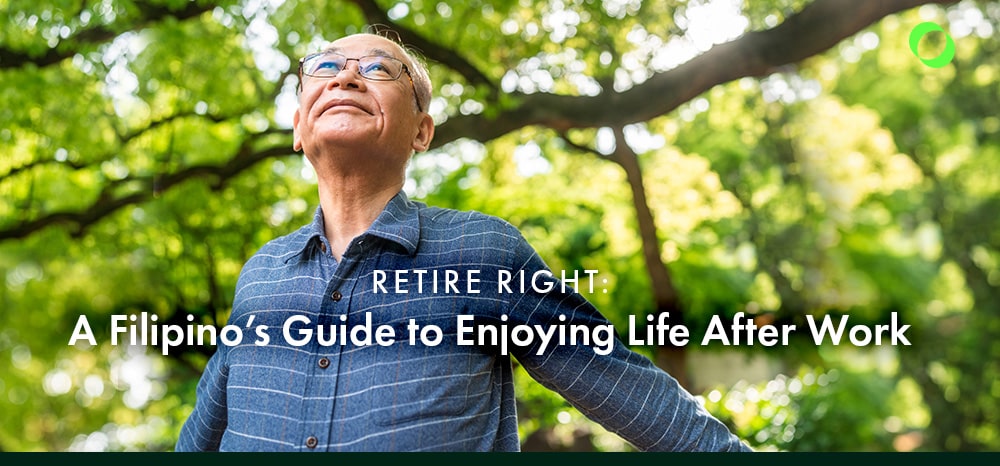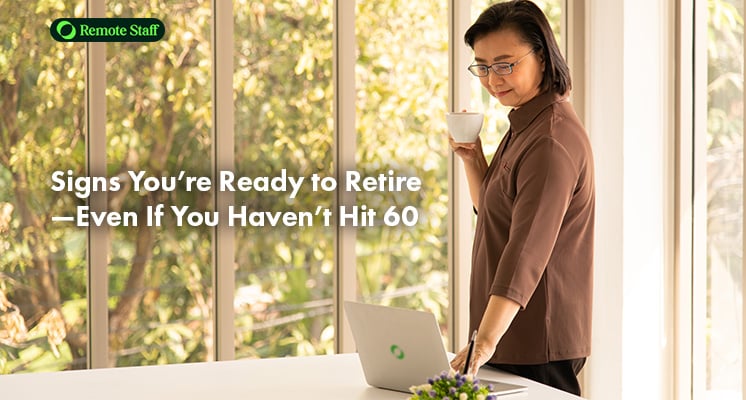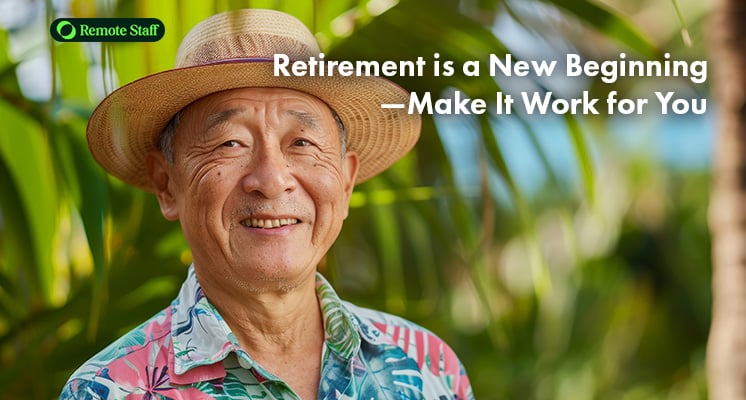Retirement isn’t simply about leaving your job. It’s about entering a new chapter filled with purpose, balance, and joy.
Some dream of quiet days in the province. Others look forward to more time with family or finally exploring hobbies and interests they once had to set aside.
Now, the timing of your retirement can shape how rewarding this next stage will be.
However, knowing when to retire isn’t always easy. The right time varies from person to person.
For many Filipinos, the decision isn’t always about reaching retirement age. Financial stability, health, family responsibilities, and personal goals all play a part in deciding when to leave the work force too.
That’s why some aim for the happiest retirement age, when they feel the most fulfilled and prepared—not just financially, but emotionally and mentally too.
For example, some choose early retirement so they can travel, spend more time with family, or enjoy life while they’re still in good health.
Others prefer to retire at a more traditional age because they want to see certain goals through, support their children’s further studies or early career, or continue working in a job they love.
So let’s explore the concept of a “perfect” retirement age in the Philippines—and whether such a thing truly exists.
Is There Really a “Perfect” Retirement Age in the Philippines?
In the Philippines, the legal retirement age is 60 (optional) or 65 (mandatory for most workers).
Still, many Filipinos retire earlier or later depending on their financial situation, health, and personal goals.
In 2023, nearly 5 million Filipinos aged 60 and above were still working—a 6.5% increase from 2022 and a 33% jump over five years.
Moreover, a 2024 survey revealed a gap between expectations and reality: most workers plan to retire at 65, yet the average retirement age among today’s retirees is 58.
Some even aim for the earliest retirement age possible, while others postpone retirement due to rising living costs, financial pressures, or the desire to stay active.
These numbers reflect a shift in how Filipinos view retirement.
In urban areas, some people work toward early retirement so they can enjoy life while they’re still healthy.
Others delay it to grow their savings, support extended family, or keep doing work they find meaningful.
There’s no one-size-fits-all answer. The right retirement age depends on your income, health, responsibilities, and how you want to spend your time.
For many, the retirement satisfaction age isn’t defined by the law—but by the age they’re at when life finally feels more secure and fulfilling beyond work.
So how can you tell if you’re truly ready to take that next step?
Signs You’re Ready to Retire—Even If You Haven’t Hit 60
Retirement isn’t always about reaching a certain age.
For many, it’s about when your finances, mindset, and life goals begin to align. You might feel ready long before 60—and that’s perfectly valid.
Here are some factors to help guide your decision:
Financial Preparedness
If you’ve built enough savings, have a reliable pension or income stream, and have set aside enough for future needs like healthcare or emergencies, you may be financially ready to retire.
This confidence often comes from having a clear retirement income strategy—a plan that ensures your money lasts throughout your retirement years.
A key part of this is knowing when to start saving for retirement. The earlier you begin, the easier it is to grow your funds and stay on track with your financial goals.
A common rule of thumb is to build a retirement fund that’s 20 to 25 times your expected annual expenses.
For instance, if you plan to spend ₱300,000 a year, you’ll need around ₱6 to ₱7.5 million saved or invested to retire comfortably.
To stay on track, it helps to create a retirement fund timeline—a step-by-step plan showing how much to save each year until you’re financially ready.
This also helps in calculating your retirement age based on your current progress and future goals.
You can check out this guide to start building your retirement fund.
Emotional Readiness
Emotional readiness means you’re ready for a big life change—once your finances are in place.
Say, you look forward to having more time to travel, spend more time with family, or work towards a different dream.
On the flip side, feeling tired or burned out can also be a sign that it’s time to move on from full-time work.
Family and Life Goals Alignment
Retirement is easier when it suits both your family’s situation and your personal goals.
Let’s say your kids are grown or your partner is also retiring. Maybe you’re thinking of moving to the province, starting a small business, or just enjoying more free time.
It also helps when your family is fully aware of and support your plans.
Planning a Retirement That Makes You Happy
A happy retirement starts with knowing your retirement lifestyle goals—how you want to live each day once you leave the work force:
Identify Your Passion Projects and Hobbies
What have you always wanted to do but never had time for?
Retirement is the perfect chance to explore old hobbies or try something new—like painting, baking, gardening, or even learning a musical instrument.
Doing things you enjoy keeps your mind active and your days meaningful.
Set Realistic Daily Routines and Goals
Without work to provide structure to your day, it’s easy to feel lost.
Creating a simple daily routine—like morning walks, reading time, or scheduled family calls—can help you stay focused and energized.
Join Clubs, Volunteer, or Teach Part-Time
Staying connected with others is important for your well-being.
Joining local clubs, volunteering in your community, or teaching part-time can help build strong social connections after retirement.
These activities also support an active retirement lifestyle, keeping you engaged, purposeful, and connected to others.
Find the Right Balance
A meaningful retirement isn’t about choosing between complete rest and constant activity—it’s about achieving your version of post-retirement wellness.
Enjoy this time to recharge, but don’t ignore opportunities to stay mentally, emotionally, and even physically engaged.
Whether that means embracing new experiences, pursuing lifelong learning, or giving back to the community, striking the right balance can lead to a deeply rewarding retirement.
Where You Choose to Retire Matters Too
Retirement isn’t just about what you do—it’s also about where you choose to settle.
Your habitat can shape your daily routine, cost of living, access to healthcare, and overall happiness.
Some retirees prefer urban areas for their convenience—proximity to hospitals, shopping centers, and transportation. Others are drawn to the peace and simplicity of rural or island life, where expenses are often lower and nature is just outside your door.
What’s best for you depends on the kind of lifestyle you want and the kind of support you’ll need as you age.
Living Independently vs. Staying with Family
First, consider your living arrangements.
Living independently offers privacy and control over your routine. It’s ideal for retirees who are in good health, are financially secure, and value their personal space.
On the other hand, living with family can help reduce costs and strengthen family bonds, especially if you want to help care for grandchildren or receive support yourself.
There’s no one-size-fits-all answer—what matters most is choosing what works best for your values, needs, and comfort.
Popular Retirement Spots in the Philippines
Once you’ve thought about your ideal living arrangements, the next step is choosing the right location.
From cool mountain towns to coastal hideaways, the Philippines offers a wide range of retirement destinations to match different lifestyles and budgets.
Each location has its own mix of scenery, services, and pace of life—making it easier to find a place that feels just right for your next chapter.
Tagaytay & Baguio
These cities are known for their cooler mountain climates and scenic views—perfect for those wanting a peaceful lifestyle without sacrificing the convenience of nearby amenities.
- Cost of living: Moderate — higher than most rural areas (Php 30k – Php 45k/month), lower than Metro Manila.
- Healthcare: Good access to hospitals and specialists in nearby Manila or La Trinidad.
Iloilo
Iloilo offers a mix of city convenience and relaxed living. It has good roads, public services, affordable costs, and quality healthcare.
It’s also a great base for short trips to nearby destinations like Guimaras (known for its mango farms and island hopping), Bacolod (a short ferry ride away with cultural spots and food trips), and Boracay for beach getaways.
- Cost of living: Php 40k– Php 60k/month for a comfortable lifestyle.
- Healthcare: Excellent; many hospitals and clinics available.
Puerto Galera (Mindoro)
Puerto Galera is a beach town known for diving, white-sand shores, and relaxed island living. It’s a good option if you want nature, peace, and a slower pace.
The area is also recognized by UNESCO for its rich marine life.
It’s also close to Metro Manila—just a few hours away by bus and ferry—making city trips easy and accessible.
- Cost of living: Php 30k – Php 45k/month
- Healthcare: Basic care is available locally; for major medical needs, head to Batangas or Manila.
Bantayan Island (Cebu)
Bantayan Island is a peaceful and beautiful spot off the northern coast of Cebu.
It’s known for its white-sand beaches, friendly locals, and slow, quiet lifestyle—ideal for retirees who want to live away from busy cities.
Fresh seafood and local produce are also cheap and easy to find.
Healthcare on the island is basic, with small clinics and pharmacies. For bigger medical needs, you can travel to Cebu City by ferry, where major hospitals and specialists are available.
- Cost of living: Php 30k – Php 40k/month
- Healthcare: Clinics available on the island; advanced care in Cebu City via ferry.
Panglao (Bohol)
Panglao is a small island in Bohol known for its white-sand beaches, clear waters, and relaxing vibe.
It’s perfect for retirees who enjoy beach life, but still want easy access to city services.
The island has its own airport, making travel to and from Manila or Cebu more convenient.
Living here is a bit more costly than in other provinces, but still relatively affordable compared to big cities.
Healthcare is available in nearby Tagbilaran City, just a short drive away, with hospitals and clinics for most medical needs.
- Cost of living: Php 60k – Php 70k/month
- Healthcare: Accessible via nearby Tagbilaran City
Dumaguete
Often ranked as the top retirement city, thanks to its affordability, healthcare availability (e.g., Silliman Medical Center), seaside atmosphere, and active local and expat community
- Cost of living: Php 30k – Php 40k monthly for basic comforts; Php 40k – Php 50k for a more relaxed lifestyle with entertainment expenses.
- Healthcare: Easy access to private hospitals and specialists in the city.
Samal Island (Davao)
Samal Island is a quiet place known for white-sand beaches, fresh seafood, and relaxing island life.
A bridge connecting the island to Davao City is under construction as of this writing, which will make travel to hospitals and shopping centers much easier in the future.
- Cost of living: Around Php 30k – Php 40k/month, depending on your lifestyle.
- Healthcare: Basic clinics available on the island; for more advanced medical needs, you can go to Davao City, which has top hospitals
Financial Tools to Make Retirement Comfortable
A comfortable retirement starts with early preparation.
Ideally, your retirement planning age should begin in your 30s or 40s—when you can still build savings gradually and take advantage of compounding growth.
Starting early gives you more time to grow your pension, invest wisely, and prepare for the lifestyle you want after work.
Start by checking the retirement programs are already available to you:
Use Government and Private Retirement Programs
Take advantage of available programs designed to support Filipinos in their senior years:
- SSS or GSIS – Government pensions that provide monthly income to qualified retirees.
- Pag-IBIG MP2 – A voluntary savings program with higher dividends than regular savings accounts, ideal for mid- to long-term growth.
- Private Pensions – Retirement plans from insurance companies or banks that offer regular payouts.
- PERA Account (Personal Equity and Retirement Account) – A voluntary retirement savings program with tax perks.
You can save up to Php 100,000 per year (Php 200,000 for OFWs). Your earnings are tax-free if you withdraw after age 55 and the account has been active for at least 5 years.
These tools can form the foundation of your post-retirement income.
Supplement Your Income with Flexible Work
You don’t have to quit working entirely. Many retirees stay engaged by taking on part-time or project-based work.
Online job recruitment sites often list roles suitable for seniors who prefer flexible work so they can pace themselves.
Through remote job applications and work from home hiring platforms, retirees can explore jobs like:
- Online tutoring or part-time teaching
- Virtual assistance or customer support
- Freelance writing, graphic design, or bookkeeping
- Consulting in your area of expertise
These jobs let you stay productive and financially independent, without the stress of full-time office work.
Budget for Healthcare and Emergencies
As you age, healthcare becomes a bigger part of your budget. Make room for:
- Routine check-ups and maintenance meds
- Health insurance or senior care plans
- Emergency funds for unexpected medical needs
Setting aside money for health-related expenses can protect your retirement fund from emergencies.
What If You Didn’t Prepare for Retirement?
Not everyone gets the chance to plan early—and that’s okay.
If you’re nearing retirement or already there with limited savings, you can still take steps to improve your situation.
Make the Most of What You Have
Take inventory of all your assets—land, skills, past work experience, or even hobbies. You might be able to turn these into extra income.
Downsize or Relocate Smartly
Consider moving to a smaller home or a more affordable location. A lower cost of living can help your limited funds go further.
Look Into Online Job Options
Many retirees find success through remote job applications.
You can explore work-from-anywhere opportunities that match your skills and comfort level. These roles are often flexible and do not require full-time hours, making them suitable for a retirement lifestyle.
Ask for Guidance
If you’re feeling stuck, reach out to someone you trust or a professional who can help you build a basic plan.
Even small steps like reorganizing your debt, applying for assistance, or finding low-cost housing can help create a more stable future.
Tips for Managing a Steady Income After Retirement
Planning your finances is key—but so is creating a lifestyle that supports your long-term comfort and peace of mind.
Here are some tips to help you maintain both stability and satisfaction in retirement:
Strengthen Your Financial Foundation
Start saving early and use long-term tools like Pag-IBIG MP2 and PERA to build your fund gradually.
- Diversify your income sources—don’t rely solely on one stream. Combine your pension, savings, investments, and freelance or part-time work.
- Automate bill payments and savings to reduce daily financial stress.
- Track your monthly expenses to avoid overspending and adjust when needed.
- Review your financial plan annually to stay aligned with your lifestyle and needs.
Support a Sustainable Retirement Lifestyle
Retirement isn’t just about money—it’s also about how you spend your days.
- Create a simple routine that includes activities you enjoy, like reading, walking, or gardening. Avoid big changes all at once. Give yourself time to adjust.
- Set small goals to keep life interesting—try something new, join a group, or work on a hobby.
- Stay connected with others. Talking to family or joining community groups can boost mental health in retirement and help you feel less alone.
The key is balance. When your lifestyle supports your well-being, retirement becomes more fulfilling and easier to enjoy.
FAQ: Retirement in the Philippines
Got questions? Here are quick answers to help you plan your retirement with ease.
Can I retire before age 60 in the Philippines?
Yes. While 60 is the optional retirement age and 65 is mandatory for most jobs, you can retire earlier if you’re self-employed or financially ready.
Some choose a healthy retirement age—so they can still enjoy their active years. Just remember, SSS pensions start at 60, so you’ll need other income sources if you retire earlier.
What is the average monthly expense for retirees in the PH?
It depends on your lifestyle and location.
For a modest lifestyle, especially in rural areas, Php 30,000 – Php 40,000 per month may be enough.
In cities or tourist destinations, a comfortable lifestyle may cost Php 50,000 – Php 75,000+ monthly, especially if you factor in rent, food, utilities, healthcare, and leisure.
How can I stay productive during retirement?
Productivity in retirement looks different for everyone.
Some enjoy freelance or remote work, volunteering, or picking up hobbies and new skills.
Others find fulfillment in quiet routines—spending time with family, enjoying nature, or simply resting.
It’s okay to slow down. What matters is finding a rhythm that feels right for you, whether that means staying busy or simply enjoying a slower pace of life.
Is early retirement risky if I don’t have a big pension?
Yes, it can be—if you haven’t planned for it. Without a stable pension or large savings, retiring early may lead to financial stress.
To reduce risk:
- Build passive income through savings or investments
- Use tools like Pag-IBIG MP2 or a PERA account
- Consider remote job applications or part-time work to supplement your income
Remember, the perfect retirement age isn’t a fixed number—it’s when your finances, health, and personal goals align.
Planning ahead gives you more freedom to retire on your own terms.
Conclusion: Retirement Is a New Beginning—Make It Work for You
Retirement opens the door to a new chapter—one where you have more freedom to focus on what truly matters.
Some Filipinos retire early to enjoy travel, quality time with family, or pursue hobbies they’ve always wanted to try. Others continue working part-time or online to stay engaged and earn extra income.
There’s no “perfect” retirement age. What matters is finding the balance that suits your health, finances, and lifestyle goals.
Want to stay productive with flexible income? Remote Staff offers flexible job postings and work-from-anywhere openings ideal for retirees. You can take on remote roles that match your lifestyle and skills.
Ready to get started? Register with Remote Staff today and discover online jobs that fit your next chapter.





